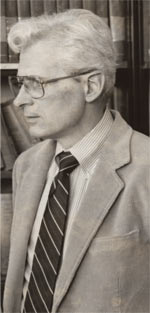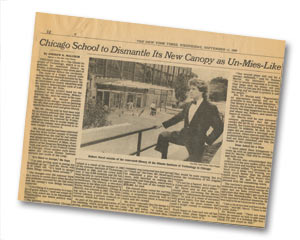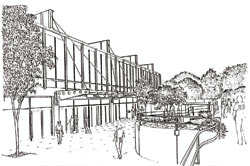
IIT Archives is processing the papers of John D. Root (1940–2004), a professor of history who spent his entire academic career at IIT (1969–2001). This collection—which includes many photocopies of documents and publications on English Catholic Modernism that can be found in original form only in European archives—will be made available to the public in early 2009.
It’s perhaps not surprising that a humanities professor would posit that “every military man should be a humanist.” For John Root these words were more than a philosophical statement and borne of experience as a platoon leader in the Vietnam War. He lived and taught as a humanist, advocating for all IIT faculty and students, and lending his voice to campus issues that he viewed as a challenge to the integrity of the university.
Root received his B.A. from the University of Notre Dame in 1962 and his M.A. from Indiana University in 1964. From 1966–68 he served with the United States Army in Vietnam, attaining the rank of captain and receiving two Bronze Star Medals. Root’s strong interest in modern history was given sharper focus by his wartime experiences.
In 1969, Root became an instructor of history at IIT and worked his way up to full professor in 1987. He was chair of the IIT Department of Humanities from 1983–1998, fighting for the retention of humanities programs and staffing in an era of cost cutting at a technology-focused university that would naturally seek to protect its basic posture in the sciences above all else. Yet, Root succeeded in saving the humanities agenda.
His academic specialty was Roman Catholic Modernism in the period 1885–1925, and on its face one would be hard-pressed to find a subject more removed from the IIT curriculum. Root spoke to IIT audiences that were appreciative of his insights into the relationship between scientific and religious/spiritual truths. Although he suffered from multiple sclerosis, which prematurely aged and physically limited him in a university context—where being, or at least acting, young is almost a core requirement—his own physical disability made him a strong and convincing advocate for improved physical access at IIT for all who work and study at the university.
Finally, Root’s service in Vietnam engaged his already sensitive and observant qualities and created a strong scholar of the American experience. Student-authored evaluation forms in the Root Papers testify to the powerful messages that Root delivered in his classes on the Vietnam War about the roles of power, history, culture, and personal responsibility in the implementation of policy. His publications included dozens of articles, book reviews, and conference papers.

Root was also deeply involved in university affairs beyond the humanities department. He was an officer of the Faculty Council, a pre-law advisor, and served on numerous university committees. He headed the committee that guided the creation of Paul V. Galvin Library in 1985. Root retained an office at IIT following retirement in 2001, and not long after his sudden death in 2004, his papers were transferred directly from his office to the IIT Archives, without being culled either by himself or any family members.
Root’s papers provide a comprehensive overview of his entire career and demonstrate his care in documenting his various activities and communications, both within the IIT community and outside (with fellow scholars, particularly in the field of Catholic Modernism studies). The collection will serve as an important primary source for research into IIT’s academic and administrative culture in the 1980s and 1990s, as well as for English Catholic Modernism.
The “Library Fiasco”

A good example of Root’s activism, observant nature, and history acumen is found in a file among his papers titled “Library Fiasco.” Inside is a neatly typed, single-spaced, three-page “Chronology of the Library Canopy Saga, May–September 1985,” in which he recounts the literal rise and fall of a post-Modernist canopy that was briefly installed above the entrance of Galvin Library in September 1985; it was removed within 48 hours after it went up, following protests that the canopy was incompatible with the strictly modern lines and angles of the Walter Netsch-designed building (1962). At that time, IIT had decided to sever its agreement with the John Crerar Library, which was a private library housed in what is now Galvin Library. Root’s committee was charged with negotiating the termination of Crerar’s tenancy and also discussing “the possibility of structural modifications to allow entrance directly to the main floor of the library” (Root Papers). This idea was dismissed as being unworkable and too expensive.
By the beginning of 1985, Root had learned from campus authorities that the entrance to the library would remain on the ground floor but that a canopy would be erected over it. Under the date “17 May (Friday),” Root wrote, “By chance, I saw drawings in office of David Dowell [library director]. Upset that I and the Planning Committee had no previous knowledge. David told me that the final plan would be complete and contracts let by the following Tuesday. He told me that no one from Crown Hall [IIT College of Architecture] was involved.”
Root immediately saw the possible political and aesthetic dangers in modifying one of the university’s key Modernist buildings without involving the various stakeholders. “I also expressed amazement that the firm that had actually built the library (I believe Skidmore) had not been consulted,” he wrote.
“30 May. I wrote to President Martin about the above, emphasizing that it was imperative to solicit Crown Hall advice since a Miesian building was about to be altered.” Root then writes that he was unable to remain in close touch with the key players in the unfolding drama as he and they had “conflicting travel schedules” over the summer months. “The library was out of my mind until 29 August, when Martin asked me to speak at the September 13th dedication.”

“3 September (Tuesday). The day after Labor Day, the steelworkers began installing the canopy, and everyone on campus was shocked to see the very un-Miesian yellow, blue, and white beams, suspended by red cable…. That afternoon, Martin holds a meeting of his administrative staff, all of whom express general opposition to the canopy.”
A decision to remove the canopy was taken on September 6, Root recorded, and on September 10 it was “removed by nightfall.” “11 September (Wednesday): Tribune front page story with color photo. Also in N.Y. Times with photo. Other reporters flock to campus; all disappointed that the canopy was gone. I was interviewed by the Washington Post and the Wall Street Journal.
“Coda. In all this, my heart went out to the Galvin family. We all played it as straight as possible. As the canopy was coming down, the last pain [sic] was being applied to the interior. Black paint was applied to marred outside steel surfaces and the last letter of Paul V. Galvin’s name was place over the entrance at 4:15 p.m. on September 13th. At 5:00 p.m. the open house and touring of the ‘new’ library began. The black-tied and gowned guests sipped cocktails in the Faculty Club at 6:00 p.m., and the formal dinner in the ballroom began at 7:00 p.m. It was a splendid event, classy and carried off with class. No jokes, only praise for the good we had done for the past two and a half years.”